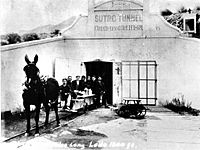Sutro Tunnel facts for kids
Quick facts for kids Sutro Tunnel |
|
|---|---|

The entrance to the Sutro Tunnel in the late 1800s
|
|
| Reference no. | 85 |
The Sutro Tunnel is a very long tunnel built in Nevada. It was designed to drain water from the famous Comstock Lode silver and gold mines. This tunnel starts near Dayton, Nevada and stretches about 3.88 miles (6.24 kilometers) northwest to the Savage Mine in Virginia City, Nevada.
Contents
Why the Tunnel Was Needed
The idea for the Sutro Tunnel came from Adolph Sutro, a smart mining businessman from Prussia, in 1860. The mines in the Comstock Lode were getting deeper and deeper. This caused a big problem: lots of water would flood the mine shafts. Miners used pumps, but they weren't strong enough to keep the water out. This flooding made it very hard to explore for more valuable minerals.
Adolph Sutro suggested building a large drainage tunnel. This tunnel would help remove the water and make it safer and easier for miners to reach deeper parts of the mines.
Getting Approval and Facing Challenges
By 1865, Sutro's plan was approved by both the state and federal governments. At first, the big mining companies in the Comstock Lode liked the idea. However, they soon changed their minds and opposed it. They worried that a new way to access the Comstock minerals would challenge their control over the gold and silver mining business.
Despite this opposition, Sutro didn't give up. He started the Sutro Tunnel Company. To raise money, he sold stock certificates, which are like shares in a company. Local miners also helped fund the project. They were very motivated because they wanted safer working conditions in the mines.
A Push for Safety
The need for safety became even clearer after a terrible event called the Yellowjacket mine disaster. In this fire, many miners died because they couldn't escape the burning mine. Adolph Sutro used this tragedy to show how important his tunnel was for protecting miners' lives.
Building the Tunnel
Construction of the Sutro Tunnel began in 1869. A skilled engineer named Arthur De Wint Foote worked on the tunnel in 1873. However, he was fired in 1874 after hitting a large amount of water in one of the tunnel shafts.
The main part of the tunnel finally connected to the Savage Mine in 1878. The North and South branches of the tunnel were finished in 1879. On June 30, 1879, water from the mines began flowing out through the tunnel.
After Completion
Once the tunnel was complete, Adolph Sutro sold his share in the company. He remained on the board of directors and moved to San Francisco. There, he later became mayor and built famous places like the Sutro Baths. His brother, Theodore Sutro, then managed the Sutro Tunnel Company until 1894, when he sold it to Franklin Leonard Sr.
The Sutro Tunnel was a groundbreaking project. It was one of the first large drainage and access tunnels built for mines in the United States. Its success inspired other similar projects, such as:
- The Argo Tunnel in Idaho Springs, Colorado
- The Leadville and Yak tunnels in Leadville, Colorado
- The Roosevelt tunnel in the Cripple Creek district, Colorado
Preserving History
Today, a group called "The Friends of Sutro Tunnel" is working to protect this important part of Nevada's mining history. Their goal is to restore the Sutro Tunnel Site. They want to keep the site historically accurate and also make it safe for visitors to explore. The first part of their project involves cleaning up the site and protecting the remaining structures from falling apart.
Popular Culture
The famous American writer Mark Twain mentioned the Sutro Tunnel in his book Roughing It.
See also
 In Spanish: Túnel Sutro para niños
In Spanish: Túnel Sutro para niños

